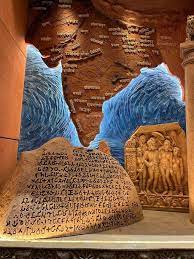
Bangladesh government concerned about ‘Akhand Bharat’ map in new Indian Parliament building
The Government of Bangladesh has instructed its mission here to contact the Ministry of External Affairs about the “Akhand Bharat” map placed in the new Parliament building. Minister of State for Foreign Affairs Shahriar Alam told journalists in Dhaka that the Awami League government is in the process of seeking clarification from India regarding the map that has drawn protests from Nepal and Pakistan as it shows the spread of ancient Indian kingdoms from the west to the east of the subcontinent that covers present-day India, Pakistan, Bangladesh and Nepal.
Mr. Alam’s remarks came two days after the Leader of the Opposition Bangladesh Nationalist Party described the mural as a “threat to the freedom and sovereignty of Bangladesh”. “There is widespread anger over the map. There is no doubt about its installation. However, for further clarification, we have asked the mission in Delhi to speak to the Indian Ministry of External Affairs to find out what their official explanation is,” said Mr. Alam who was quoted in Dhaka Tribune.
The mural was part of the elements on display in the new parliament building that was dedicated to the nation on May 28 by Prime Minister Narendra Modi.
‘Resolve is clear’
The new item drew attention after Parliamentary Affairs Minister Pralhad Joshi remarked saying “Resolve is clear – Akhand Bharat” indicating that the Government of India wishes to create a geographical unit resembling the mural. Arindam Bagchi, Official Spokesperson of the Ministry of External Affairs (MEA) had last Friday clarified that the mural depicted the spread of the Mauryan period in Indian history and said, “The mural in question depicts the spread of the Ashokan empire and the idea of a responsible and people-oriented government he adopted and propagated. That’s what the plaque in front of the mural says.”
Mr. Bagchi’s clarification came soon after former Prime Minister of Nepal Baburam Bhattarai criticised the map which depicted Lumbini, the birthplace of Lord Buddha as part of the ancient Indian landmass. Mr. Alam acknowledged Mr. Bagchi’s comment and said the mural does not depict a political reality and shows a cultural spread saying, “The mural depicts the journey of people. there may be cultural similarities, but it has nothing to do with politics.”
Pressure on Hasina
The explanation from Mr Alam shows growing pressure on the government of Prime Minister Sheikh Hasina from the opposition that has cornered her over the electricity crisis which has escalated after the largest thermal power station in Bangladesh stopped functioning on Monday. Bangladesh has stopped purchasing coal because of a shrinking dollar reserve. The dollar crisis has deepened against the backdrop of the war in Ukraine and also because of the Bangladeshi economy’s reliance on imports.
Earlier Mirza Fakhrul Islam Alamgir, General Secretary of the BNP on Sunday had expressed concern over the mural and said, “Displaying Bangladesh as part of the undivided map of any other country is a threat to the country’s independence and sovereignty.” The mural was also criticised by Hasanul Haq Inu, an alliance partner of Sheikh Hasina’s government. The Ministry of External Affairs is yet to respond to Mr. Alam’s remarks.

